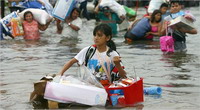Mexican authorities do nothing about Mexico flooding
The Mexico's government could forecast the flooding in the state of Tabasco and save more than 1 million homes.

But officials admit they never finished a US$190 million (130 million EUR) levee project that was supposed to have been done by 2006 and would have held back much of the rising waters that flooded Tabasco at the end of October.
The tragedy was reminiscent of the Hurricane Katrina disaster in 2005, when levees failed and swamped much of New Orleans, forcing people to flee by wading through dirty waters. In Tabasco, days of relentless rain - not a hurricane - were to blame.
Tabasco Gov. Andres Granier said 280 people are still unaccounted for three weeks later, although he thinks many of the missing are likely just separated from family members and living in shelters. The flooding killed at least 33 people in Tabasco and Chiapas.
With water receding this week, people are returning to clean out their homes as questions pile up over what went wrong.
Nadia Gomez, the 24-year-old wife of a car mechanic in a slum on the outskirts of Villahermosa, said the government didn't do enough to protect low-lying neighborhoods.
"Maybe if they had built more defenses it would have been all right. But they only care about the rich people of Tabasco, not the poor," Gomez said, standing with her three children outside her flooded shack.
Both the state and federal government acknowledge Tabasco wasn't prepared for unusually heavy rains that hit in October, even though a flood-control plan had been drawn up after flooding in 1999 left tens of thousands homeless and caused US$375 million (365 million EUR) in damage.
In 2003, officials announced the Integral Project Against Flooding, which called for building 179 kilometers (110 miles) of levees and 190 kilometers (120 miles) of drainage canals along the Grijalva, Carrizal and Samaria rivers.
But state officials admit they never finished the levee project, 72 percent of which was funded by the federal government.
It's not known what happened to the money earmarked for the project. State officials say the federal government didn't deliver all the money. Congress members responsible for allocating the funds left office last year and it isn't clear who was responsible for overseeing that part of the budget.
Gilberto Segovia, the Tabasco spokesman for the National Water Commission, said about 70 percent of the levees and drainage canals were built. Although the original plan called for all to be completed by 2006, former Gov. Manuel Andrade, who left office last Dec. 31 and was largely responsible for carrying out the levee project, had extended the deadline to 2012.
Fingers also are being pointed at the Federal Electricity Commission.
Critics say it waited too long to let begin letting water out of a dam upstream, forcing workers to release a huge amount in a short time when the reservoir level surged. The agency also gave little warning to people downstream about the impending disaster, critics contend.
Some people also blame deforestation in Mexico's highlands, saying that has lessened the ability of mountainous terrain to absorb heavy rainfall and reduce runoff into low-lying areas like Tabasco.
Sen. Arturo Nunez, a leftist politician from Tabasco, says officials at all levels failed.
"It's clear they didn't take all the precautions that they could have, many of which were clear after what happened in 1999," he said. "While we may not have been able to avoid the tragedy, it wouldn't have had the same dimension and magnitude."
Federal water officials are investigating alleged failures or misconduct and will release the results publicly, although the deadline is not clear, Segovia said.
"We are going to get to the bottom of this ... and if someone is responsible, they will be publicly named," he said.
Mexico's Senate has called key federal officials to testify about what might have been done to avoid the disaster. Hearings are expected to begin in the next few weeks.
Natural disasters haven't been limited to Tabasco, nor have accusations of inaction or possible corruption.
At the same time Tabasco was under water, a rain-soaked hillside collapsed into a river in southern Chiapas state, sending a wall of water crashing over a small community. Fifteen bodies were recovered and 10 more people are still missing.
Residents in the area complained that the government never followed through on promises made nearly three decades ago to relocate people who had been displaced by a nearby dam. As a result, many of those people settled next to the river because they needed an easy source of water.
Chiapas officials have refused to comment publicly on the matter, but this week they began relocating 6,000 people who live in communities along the still-rising Grijalva River.
Authorities in Tabasco also began forcibly removing hundreds of people from an area at risk of landslides.
Despite the complaints about the lack of preparations, officials and even some critics say state and federal agencies could not have completely prevented the October flood because so much rain fell in such a short time.
The National Water Commission said 776 millimeters (30.5 inches) of rain fell in October in Tabasco state, with (303 millimeters) 12 inches falling on Oct. 28-30. The average for October is just 378 millimeters (15 inches).
"Simply put, the unprecedented levels that several rivers reached indicate that the rain was the main cause of the tragedy," said Segovia, the water commission spokesman.
Subscribe to Pravda.Ru Telegram channel, Facebook, RSS!


